Talk with our local travel specialist who can help organize your trip.
10 Must-Visit Tibetan Monasteries and Temples in Tibet
Tibet, one of the most beautiful countries in the world, is popularly known as the "Roof of the World." Home to beautiful tibetan monasteries, stunning landscapes, the highest mountains, and natural wonders, Tibet offers some of the most exotic travel destinations in the world. From Mount Kailash to Potala Palace to Sera Monastery, Tibet got every element to draw the wanderlust in a traveler. And every year, thousands of tourists visit Tibet to explore its beauty. Whether you visit UNESCO World Heritage sites, embark on a spiritual journey to monasteries, or indulge in high-altitude treks, Tibet will surely excite you. Here are 10 Must-Visit Tibetan Monastries and Temples in Tibet that you visit:
Table of Content
1. Potala Palace

Potala Palace is one of the three UNESCO World Heritage sites in Tibet and the highest palace in the world. Perched on the side of Ri Marpo in the center of Lhasa, Potala Palace is the greatest monumental structure in all of Tibet. The 13-story palace building covers an area of over 100,000 square meters and houses temples, palaces, dormitories, office areas, and more than 1000 rooms. In 1994 this site was declared one of the World's Culture Heritage by UNESCO. For its location, physical beauty, Tibetan history, this palace is also considered one of the wonders of the world. The structure of the palace rises above the rocky base, and the gilded roof touches the sky.
Potala Palace is one of the holiest landmarks in Tibet and is the highest castle in the world. The first king of Tibet, Songtsen Gampo, built the palace in 631 AD. History has it that the first palace was built for military purposes. After 200 years of its completion, the palace suffered destruction due to lightning strikes and several other reasons. The palace has two wings: Red Palace in the east and west and White Palace in the middle. Inside the palace are Murals, Thangkas, Dalai Lama stupas, scriptures, and sculptures from the 7th century. Just before it was turned into a museum by the government, it used to be the winter palace of the Dalai Lama. Today it is a major pilgrimage site for Tibetan Buddhists and a major tourist attraction for travelers.
2. Jokhang Temple

The Jokhang, also known as Jokhang Monastery, or Jokhang Temple, is the holiest temple in Tibet. Run by the Gelug school of Buddhism, Jokhang was established during the 7th century. Perched in the Barkhor Square in Lhasa, this site is considered the most sacred and "the spiritual heart of the city." Originally, the temple was built to house important Buddhist statues and images-the two statues of Jowo Sakyamuni Buddha and Akshobhya Buddha- brought from China and Nepal to Tibet by King Songtsen Gampo's wives. After his death in 649 AD, both the two statues were transferred to some other places. In 2000, Jokhang was designated a UNESCO World Heritage Site and was listed in the first group of State Cultural Protection Relic Units.
Being one of the crowning jewels of Tibet, Jokhang is the major tourist attraction in Tibet. You can visit this site all year round, but the best time to visit is in summer and autumn. The life-size image of 12-year-old Jowo Sakyamuni is the prominent highlight of Jokhang. The sacred Jowo Sakyamuni Buddha in the temple is considered the paramount relics revered by millions of pilgrims. The lively street features Tibetan culture, art, and religions on every corner. In general, travelers who visit Potala Palace definitely explore this temple. Some travelers call this temple a "FAIRY-TALE BUILDING," and you will feel the same once you visit this beautiful place in Lhasa.
Where to travel next?
Get help from our travel specialists for holiday ideas that matches your interests.
3. Tashi Lhunpo Monastery

Tashi Lhunpo Monastery is one of the few monasteries in Tibet, built by Gyalwa Gedun Drupa, the 1st Dalai Lama. Perched on a hill in the center of the city, this monastery is the traditional monastic seat of the Panchen Lama, Tibet's second highest incarnation. One of the remarkable highlights of this monastery is that it houses the tallest and largest bronze (26.2m high) Jampa Buddha statue in the world. The statue is decorated with more than 1400 precious ornaments. Home to more than 900 monks, this monastery has gained a reputation for being one of the largest functioning religious institutions in Tibet.
This monastery is also one of the Great Six Gelugpa Monasteries of Tibetan Buddhism. Arguably, it is the most popular attraction in Shigatse and Tibet. Covering an area of 300,000 square kilometers, the monastery consists of a towering building with golden roofs and white walls, the remarkable Maitreya Chapel, the Kelsang Temple, the Panchen Lama's Palace, and impressive Stupa tomb of the tenth Panchen Lama, and more. The location of this monastery itself that reveals the stunning landscape, the unique architecture, wall paintings, and historic sites are sure to amaze any travelers.
4. Drepung Monastery

Also dubbed as one of the "three pillars of the Tibetan State" alongside Sera and Ganden monastery, the Drepung monastery is the largest of all the Tibetan monasteries. It is located at the foot of Mount Gephel, about 5 kilometers from the western suburb of Lhasa. It was founded in 1416 by Jamyang Choge Tashi Palden and was known for the high standards of its academic study. At present, the monastery is divided into the seven great colleges: Gomang, Deyang, Loseling, Shagkor, Gyelwa, Dulwa and Ngagpa. Long before, the monastery was home to as many as 10,000 monks at its peak but now, according to some reports, the monastery houses 300 monks.
Drepung Monastery is also called "Nalanda of Tibet," for it has been a prominent Buddhist University in Lhasa for centuries. It houses Ganden Phodrang, four main colleges, the Coqen Hall, a debating courtyard and many Kamcuns. Coqen Hall is the main assembly hall of the Drepung temple. There are many residences with white roofs and for this reason, the monastery was also named rice heap monastery. In the account of recent events, it is stated that the monastery opened in 2013 after being shut for 5 years.
5. Sera Monastery

Sera Monastery is yet another one of the most beautiful and must-visit places in Tibet. Nestled in a beautiful location, about 2 km north of Lhasa, Sera monastery is one of the three Gelug university monasteries of Tibet. It was founded by Jamchen Chojey Sakya Yeshe of Zel Gungtang in 1419. This monastery had suffered severe damage during the 1959 revolt in Lhasa. The Sera complex houses the Great Assembly Hall, and three colleges: The Sera Je Dratsang, The Sera Me Dratsang, and the Ngakpa Dratsang. The history of this monastery attributes to Master Lama Tsongkhapa in the early 15th century.
The monastery is renowned for producing many scholars turned spiritual masters and saints. According to its history, it has attracted many students from all over Tibet and other countries like Japan, China, Mongolia and India. Please note that there are two Sera Monasteries, one the original in Tibet and the other in India. Long back, before the Cultural Revolution, there were more than 5000 monks in the monastery, but now, the site holds probably a few hundred of them. The monk's debate at the courtyard is a beautiful and interesting thing to see. They discuss with specific hand gestures in a group of two or three.
Where to travel next?
Get help from our travel specialists for holiday ideas that matches your interests.
6. Rongbuk Monastery

Rongbuk Monastery, also known as Dzarongpu, is a Tibetan Buddhist monastery perched near the Everest Base Camp north side, at the end of Dzakar Chu Valley. At 4,980 m, this monastery is purportedly the highest-elevation monastery in the world. Back in time, this monastery served as an important pilgrimage site to the Sherpas living on the south slopes of Everest in Nepal. This monastery was frequently visited by early expeditions to Mount Everest in the 1920s-1930s. Today, the monastery is easily accessible by roads from the Friendship Highway connecting Lhasa with Nepal/China border.
This monastery was founded in 1902 by the Nyingmapa Lama Ngawang Tenzin Norbu. The area in the monastery had long been used by hermits and monks for over 400 years. At present, the monastery is home to a few monks and nuns. Monks and nuns in the monastery celebrate the festival together in the month of April, a Buddhist dancing ceremony. In close proximity to this monastery is the famous Rongbuk glacier. Travelers can witness stunning views of Everest from the monastery, apart from soaking up the beauty of the monastery. For a beautiful hike from the monastery, follow the trail south to the ruins of Rong Chong.
7. Norbulingkha

Built in 1755 (completed in 1783), Norbulingka is perched on the west side of the capital city of Lhasa, within walking distance from Potala Palace. It is considered to be the largest man-made garden in Tibet. In the Tibetan language, Norbulingka means "Treasure Garden." Norbulingka houses 374 rooms, four palaces, a monastery, numerous halls, 30,000 cultural relics and pavilions, and a beautiful flower garden brimming with luxuriant plants that are rare in Tibet. During summer and autumn, the park in Norbulingka serves as a hub for festivals and entertainment. Arguably, Norbulingka is the most popular garden in Lhasa and has earned the epithet 'world's highest, largest and best-preserved ancient artificial horticultural garden.' It is also popularly known as the "Plateau Botanic Garden."
On 14 December 2001, Norbulingka was designated a UNESCO World Heritage Site. Norbulingka along with Potala Palace and Jokhang Temple Monastery is the historic ensemble that covers three monuments in Tibet. Norbulingka was built about 100 years after the completion of Potala Palace. It was built with the great purpose of serving the Dalai Lama in the summer season; this palace served as a summer residence of Dalai Lama from the 1780s until his exile in 1959. Kalsang Podrang, the oldest palace, built for the 8th Dalai Lama, is one of the major attractions of Norbulingka
8. Ganden Monastery

Ganden Monastery is one of the three Gelug university monasteries in Tibet, particularly popular for its unparalleled beauty. Je Tsongkhapa Lozang-dragpa founded this monastery in 1409. Located about 40km northeast of downtown Lhasa, at the top of Wangbur Mountain, Ganden monastery is a popular place and a historical landmark in Tibet. The word Ganden translates to "Joyful." During the 1959 Tibetan Uprising, this monastery was completely destroyed and rebuilding of the site has been continued since 1980s. Like other monasteries, this monastery as well houses an assembly hall, chapels, a guesthouse for visitors, and artifacts belonging to Tsongkhapa. Ganden monastery bestows breathtaking views of Lhasa and Shannan's countryside.
In the past, the monastery accommodated more than 5000 monks, and as of 2012, the number of monks has been significantly reduced to around 400 monks. The monastery with Colleges Jangtse and Shartse has been re-established in Karnataka, India. Travelers in Lhasa can quickly explore this monastery to embrace its grandeur and the view of the valley it has to offer. Besides, travelers can witness monk debating, the marvelous architecture of the monastery, and gain insights into historical events and significance. Please note the visiting hours for this monastery: 9 am to 4 pm. Since many chapels close after 12 pm, you are recommended to visit the monastery in the morning.
9. Samya Monastery

Samya Monastery is the first Tibetan Buddhist monastery, where the first Tibetan monks were ordained. Located in the piedmont area, to the south of Lhasa, this monastery was constructed between 787 and 791; in the 8th century. This monastery is popular for its sacred mandala design; the main Hall represents Mount Meru, and the outer temples represent the features of Buddhist Cosmology. Geographically, Samya monastery is located about 170km from downtown Lhasa, amidst stunning landscapes. The remarkable highlight of this monastery is that it is surrounded wall topped by 108 tiny chortens. Since its establishment, it has been a major tourist attraction of Tibet. Every year, hundreds of devout and travelers flock to Tibet to explore and embrace the grandeur of this monastery. The historical and religious significance tied with this monastery is really magical.
Samya monastery has long been attracting Tibetan Buddhists; some visit to pay reverence, some to explore and some to worship. As you navigate through the monastery, you may see four large identical but colorful chortens at the corner of the main temple or utse. You will be amazed to find historical figures of Padmasambhava, Trisong Detsen, Shantarakshita and Songsten Gampo. There's Jowo Khang Chapel that enshrines an impressive statue of Buddha. A few hours' drives from Lhasa will take you to this beautiful monastery. You will need to purchase an entrance ticket to enter the monastery.
10. Sakya Monastery

Last but not least, we have Sakya monastery in our list of top 15 most beautiful places in Tibet. Also known as Pel Sakya, Sakya monastery is a Buddhist monastery founded in 1073 by Konchok Gyelpo. The monastery houses important artifacts, relics of Sakya abbots and a huge library with as many as 84,000 scrolls, most of which is believed to be Buddhist scripture. People believed that those scrolls had remained untouched for hundreds of years. The monastery is enclosed by black-colored walls with watchtowers in all directions. According to the historical data, the monastery served as the center of political life in Tibet. Visitors get to see ancient thangkas and murals embedded on the walls of the assembly hall. The murals of mandalas are considered the most important ones.
The Sakya monastery complex has several colleges for hundreds of monks in Tibet to study. It is estimated that there are about 300 monks in the monastery. Therefore, it is also considered one of the four major schools of Tibetan Buddhism. The courtyard of this monastery witnesses the famous Cham Dance Festival every year and this is the best time of the year to visit the monastery. The monks perform holy dances and religious ceremonies. Since the monastery is just 30km off the Friendship Highway, the monastery is a must-visit place in Tibet. For those who wish to travel to Lhasa, this monastery is a definite place to visit and explore.
Conclusion
The above-mentioned places are undoubtedly must-visit places in Tibet. From Potala Palace to Yarlung Tsangpo Grand Canyon, all the 15 places draw tourists in thousands from around the globe. Some of the places enlisted in UNESCO World Heritage sites in Tibet. The enticing cultures, interesting daily lifestyle of local people, colorful monasteries, sacred lakes, and stunning landscapes are truly magical to evoke the wanderlust in you.
- Written by: Puskar Rai
Updated: Oct, 26, 2021

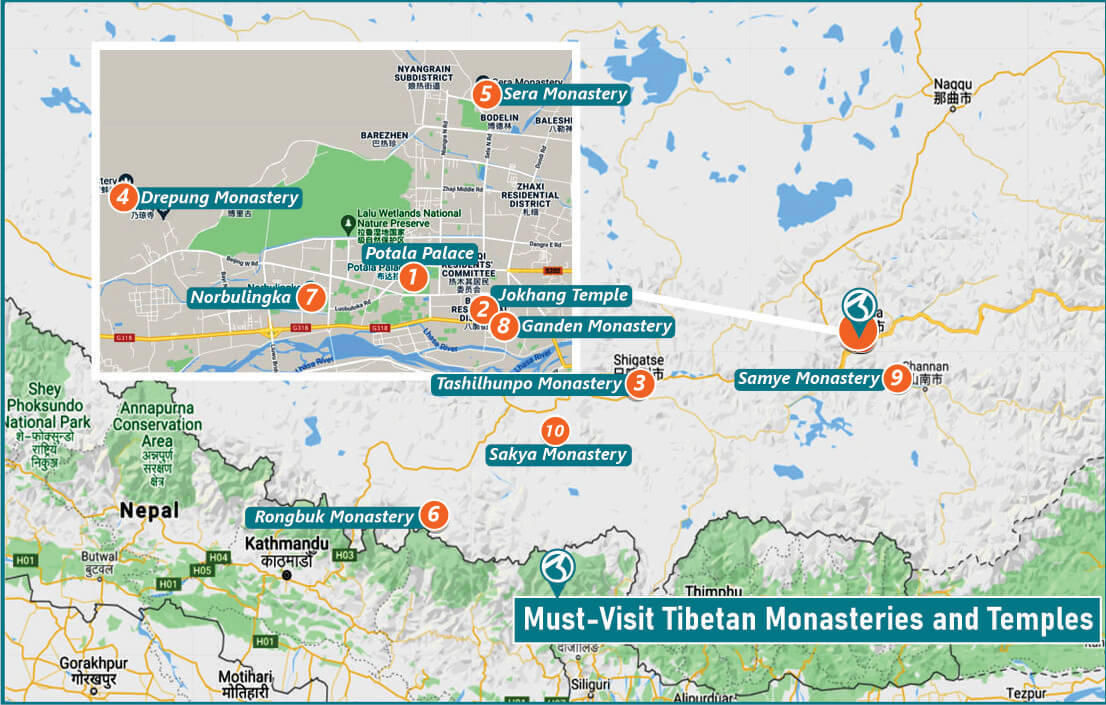
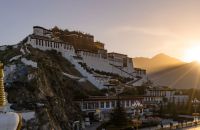
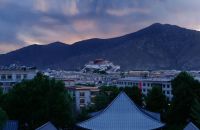
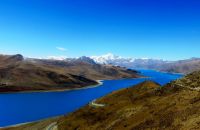
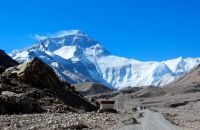
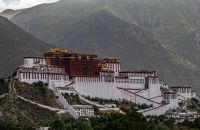





.jpegXkO.jpeg&width=200&height=130)










Recent Comments
Been to 4 of this list, now will go for the rest. Thanks for this simple-yet-beautiful blog. My wanderlust for evergreen Tibet country is now booming!!!